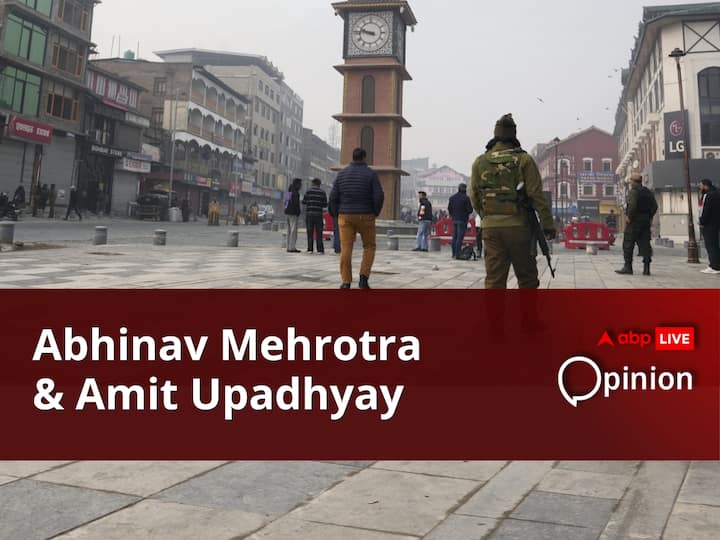How SC Verdict On Article 370 Balances Legal Norms And Political Realities abpp
[ad_1]

Security personnel stand guard at Lal Chowk after security was beefed up on the day of the Supreme Court’s verdict on a batch of petitions challenging the abrogation of Article 370 of the Constitution, in Srinagar on December 11, 2023. ( Image Source : PTI )
The Supreme Court Constitution Bench delivered a landmark verdict on the abrogation of Article 370 and bifurcation of the erstwhile state of Jammu and Kashmir into two union territories. Article 370 is a pivotal position that once granted special autonomous status to the state of Jammu and Kashmir. This SC ruling, which addressed the Constitution (Application to Jammu and Kashmir ) Order, 2019, superseding a 1954 order and restructuring the region into union territories of J&K and Ladakh, elucidates crucial aspects of the legal framework and historical significance of Article 370.
The verdict was given by a five-judge Constitution Bench of the SC led by Chief Justice DY Chandrachud in response to several petitions challenging the Centre’s 2019 move. The petitioners argued that Article 370 could not be unilaterally abrogated by the Centre since the powers of the Constituent Assembly were vested in the Jammu and Kashmir legislature after it was dissolved in 1957.
The Supreme Court bench unanimously upheld the Centre’s August 5, 2019 decision to abrogate provisions of Article 370 while directing the restoration of statehood for J&K at the earliest and holding of the assembly elections by September 30, 2024. The validity of the J&K Reorganisation Act 2019, which bifurcated the state of Jammu & Kashmir into the UTs of J&K and Ladakh had been challenged too. However, the court did not rule on this issue in view of the submission of the Solicitor General of India that the statehood will be restored soon. The apex court also upheld the reorganisation of Ladakh as a UT under Article 3 of the Constitution as it allows Parliament to carve out a UT from a state.
Article 370 Origin
Central to the court’s decision was the characterisation of Article 370 as a temporary provision, emphasising its contextual origin. The SC further stated that J&K did not possess any element of internal sovereignty by virtue of Article 370. This judgment is significant given that it establishes the legality of the 2019 Parliament action and answers in the affirmative that Parliament rightfully assumed the role of the Constituent Assembly to make amendments.
This judgment upholds the validity of the Instrument of Accession signed by Maharaja Hari Singh, the ruler of the princely state of Jammu and Kashmir, in 1947. The instrument was the legal document that ceded J&K to the Dominion of India as per the Indian Independence Act 1947. However, Pakistan refused to recognise the Instrument of Accession, and soon, the first India-Pakistan war ensued. It was in January 1948 that India submitted the Kashmir issue to the United Nations Security Council (UNSC) and highlighted that military intervention by India was carried out at the request of the ruler of the state who executed the Instrument of Accession. The UN Commission for India and Pakistan (UNCIP) was established with reference to the Kashmir dispute between India and Pakistan between June 1948 and March 1950. At the same time, UNSC Resolution 47 was adopted in 1948 and recommended solutions to both parties that required action on the part of both.
Amid all these developments, the significance of Article 370 under the Constitution increased, and it found a place under Part XXI that deals with “Temporary, Transitional and Special Provisions” that were inserted through the 13th Amendment Act, 1962 and granted special autonomous status to the state of Jammu and Kashmir. The key feature of this special autonomous status was that the central laws passed by Parliament did not automatically apply to J&K. It was the right of the state legislature to approve such laws by passing a parallel act. Further, this Article empowered the President and the Jammu and Kashmir government to determine constitutional relations between India and the state.
Power Of Parliament Cannot Be Restricted To Just Law-Making
In the wake of the SC verdict, the intricate legal and historical underpinnings surrounding Article 370 underscore the complex interplay between constitutional provisions and historical events, marking a pivotal moment in India’s legal and political landscape. The petitioners challenging the action were required to prima facie establish that it was a mala fide or extraneous exercise of power. The court found no prima facie case that the President’s orders amending Article 370 was an extraneous use of the power and was exercised in bad faith.
The court also held that the power of Parliament under Article 356(1)(b) cannot be restricted to only law-making, limiting the scope of the provision. The court further emphasised that the power under Article 370(3) did not cease to exist once the Constituent Assembly was dissolved. The President is also not required to seek the concurrence of the government of the state. Justice Sanjay Kishan Kaul, part of the five-judge Constitution Bench, also recommended setting up a Truth and Reconciliation Commission in Jammu & Kashmir to acknowledge the acts of alleged human rights violations in the region. The court further observed that the Constitution of India is a complete code in itself needed for constitutional governance of the nation. Since the Constitution of India is now made applicable to the whole of the erstwhile state of Jammu and Kashmir, the constitution of J&K is now redundant. Hence, the court directed the restoration of the statehood to Jammu & Kashmir as soon as possible.
Abhinav Mehrotra is an Assistant Professor and Amit Upadhyay an Associate Professor at Jindal Global Law School, O.P. Jindal Global University, Sonipat, India.
[Disclaimer: The opinions, beliefs, and views expressed by the various authors and forum participants on this website are personal and do not reflect the opinions, beliefs, and views of ABP News Network Pvt Ltd.]
[ad_2]
Source link